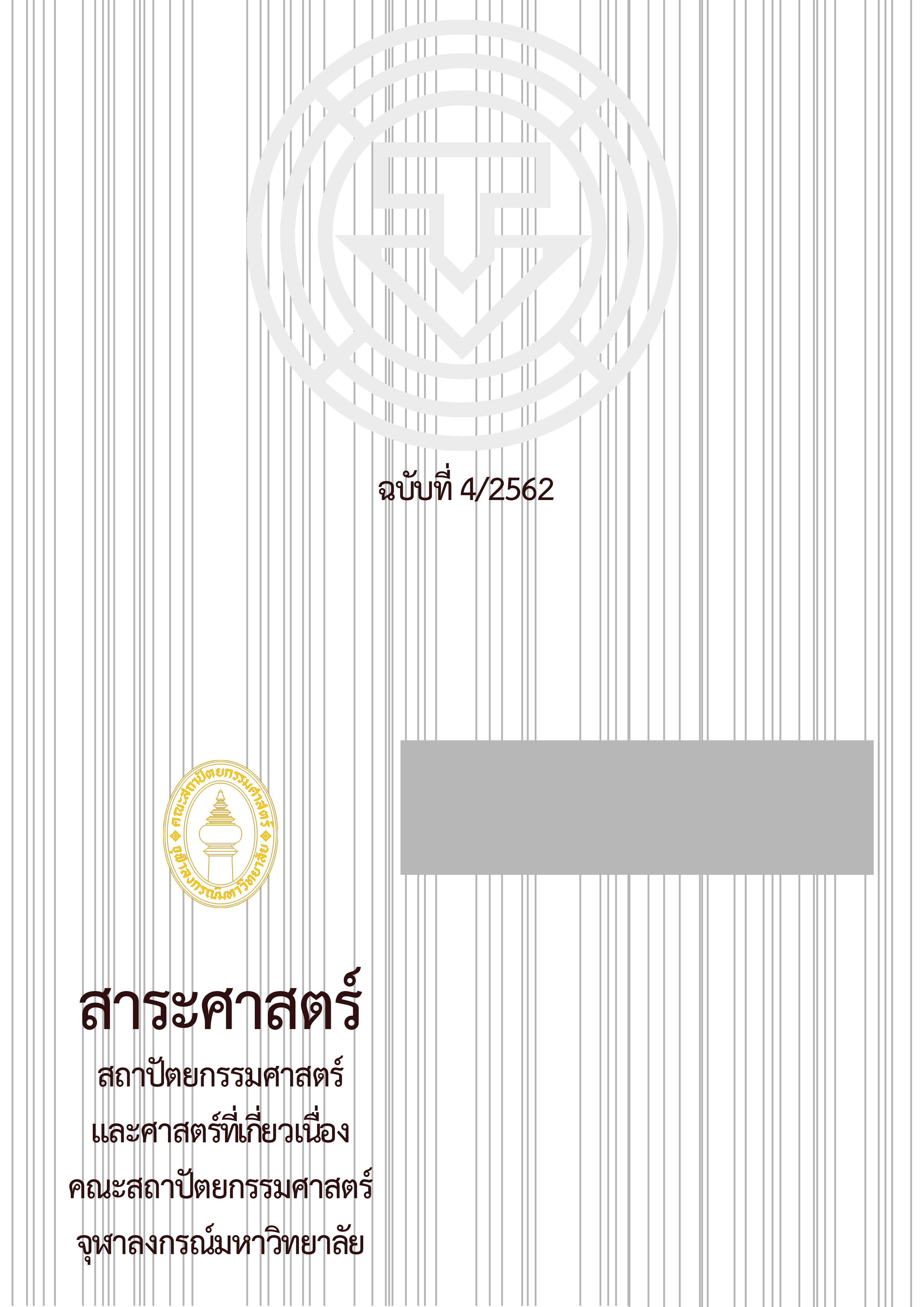การระบุขอบเขตพื้นที่ราบน้ำท่วมถึงและความสัมพันธ์ระหว่างพลวัตน้ำหลาก กับการปรับตัวของมนุษย์ กรณีศึกษาแม่น้ำมูลตอนกลาง case study of Middle Mun River Basin
Main Article Content
บทคัดย่อ
การวิจัยนี้มีจุดประสงค์เพื่อศึกษาความสัมพันธ์ระหว่างมนุษย์กับระบบภูมินิเวศของพื้นที่ราบน้ำท่วมถึง ซึ่งเป็นพื้นที่ที่มีพลวัต ความหลากหลายเชิงนิเวศ และความอุดมสมบูรณ์ อันเป็นผลมาจากพลวัตน้ำหลาก (Junk and Wantzen 2004) ซึ่งให้ประโยชน์แก่มนุษย์ในรูปแบบของการบริการเชิงนิเวศทั้งการเป็นแหล่งผลิตทรัพยากรพื้นฐานและการสนับสนุนระบบเศรษฐกิจชุมชน จากความสำคัญดังกล่าว นำไปสู่การตั้งคำถามการวิจัยใน 2 ประเด็นคือ (1) สามารถระบุขอบเขตพื้นที่ราบน้ำท่วมถึงได้อย่างไร (2) มนุษย์ปรับตัวอย่างไรเพื่อดำรงชีวิตอยู่ร่วมกับพลวัตน้ำหลากของพื้นที่ราบน้ำท่วมถึงแม่น้ำมูลตอนกลาง
การดำเนินการวิจัยใช้เทคนิคการสำรวจระยะไกลด้วยภาพถ่ายดาวเทียม (satellite remote sensing) เพื่อวิเคราะห์ใน 2 ประเด็นคือ (1) ระบุขอบเขตของพื้นที่ราบน้ำท่วมถึงในบริบทแม่น้ำมูลตอนกลางโดยใช้เกณฑ์ การจำแนกลักษณะพื้นที่ราบต่ำด้วยการวิเคราะห์เชิงสัณฐานจากแบบจำลองระดับความสูงเชิงตัวเลข (DEM) และจำแนกพื้นที่ที่เคยเกิดน้ำท่วมด้วยดัชนีความแตกต่างทั่วไปของน้ำ (NDWI) (2) ศึกษาการเปลี่ยนแปลงของลักษณะสิ่งปกคลุมผิวดินจากอดีตถึงปัจจุบัน ด้วยการวิเคราะห์ค่าดัชนีความแตกต่างทั่วไปของพืช (NDVI) ร่วมกับการลงพื้นที่สำรวจชุมชนดั้งเดิม (Aymonier 2000) เพื่อศึกษาความสัมพันธ์ระหว่างพลวัตน้ำหลากกับการใช้ประโยชน์ของมนุษย์ รวมถึงบ่งชี้ประเด็นปัญหาจากการเปลี่ยนแปลงภูมิทัศน์โดยมนุษย์ที่ส่งผลกระทบทางลบต่อการบริการเชิงนิเวศ
จากการศึกษาพบว่า ชุมชนในลุ่มแม่น้ำมูลตอนกลางมีความสามารถในการปรับตัวอย่างยืดหยุ่นเพื่อใช้ประโยชน์จากพื้นที่ราบน้ำท่วมถึงภายใต้เงื่อนไขของพลวัตน้ำหลาก จากการเลือกที่ตั้งชุมชนที่อยู่นอกเขตพื้นที่ราบน้ำท่วมถึงเพื่อหลีกเลี่ยงน้ำหลากท่วมในฤดูน้ำหลาก และใช้ประโยชน์อย่างสอดคล้องกับพลวัตน้ำหลากจากพื้นที่ราบน้ำท่วมถึง ในฐานะแหล่งทรัพยากรของชุมชนที่สามารถใช้ประโยชน์ได้ตลอดปี ซึ่งมีรูปแบบการใช้ประโยชน์ที่แตกต่างกันทั้งพื้นที่และช่วงเวลา แต่ในปัจจุบันมีการเพิ่มขึ้นของพื้นที่เกษตรในพื้นที่ราบน้ำท่วมและมีการดัดแปลงโครงสร้างของแหล่งน้ำธรรมชาติเพื่อเพิ่มปริมาณการกักเก็บน้ำและป้องกันผลกระทบจากน้ำท่วม ทำให้แหล่งทรัพยากรของชุมชนมีพื้นที่ลดลงและระบบนิเวศเสียหายจนไม่สามารถให้บริการเชิงนิเวศได้เหมือนเช่นเคย ส่งผลต่อความสามารถในการปรับตัวของชุมชนและระบบเศรษฐกิจชุมชนในชนบทที่พึ่งพิงการบริการเชิงนิเวศจากแหล่งทรัพยากรธรรมชาติ
Article Details
เอกสารอ้างอิง
Eckman, K. Rural Households and Sustainability : Integrating Environmental and Gender Concerns into Home Economics Curricula. Rome: Food and Agriculture Organization of the United Nations, 1994.
Fryirs, K. A. and G. J. Brierley. Geomorphic Analysis of River Systems: An Approach to Reading the Landscape. Chichester: John Wiley & Sons, 2013.
Junk, W. J. The Central Amazon Floodplain: Ecology of a Pulsing System. Berlin: Springer Verlag, 1997.
Junk, W. J. and K, Wantzen. The Flood Pulse Concept: New Aspects, Approaches and Applications—An Update. In Proceedings of the Second International Symposium on the Management of Large Rivers for Fisheries, Welcomme, R. L. and Petr, T. (Eds.), 117-121. Bangkok: FAO Regional Office for Asia and the Pacific, 2004.
McGarigal, K. "Overview of Landscape Dynamic Concepts." Accessed June 20, 2019. https://pdfs.semanticscholar.org/68d0/2160c1c413d41c50f198bcc944d342f8e1e5.pdf.
Nanson, G. C. and J. C., Croke. A Genetic Classification of Floodplains. Geomorphology 4, 6 (1992): 459-486.
NASA. "NASA Shuttle Radar Topography Mission Global 1 arc second [DEM data]: United States Geological Survey." Accessed September 19, 2018. https://earthexplorer.usgs.gov/.
Opperman, J. J., P. B. Moyle, E. W. Larsen, J. L., Florsheim and A, Manfree. Floodplains: Processes and Management for Ecosystem Services. California: University of California Press, 2017.
Theilen-Willige, B., A., Charif, A., Ouahidi, M., Chaibi, M., Ayt Ougougdal and H., AitMalek. "Flash Floods in the Guelmim Area/Southwest Morocco–Use of Remote Sensing and GIS-Tools for the Detection of Flooding-Prone Areas." Geosciences 5 (2015): 203-221.
Wongsomsak, S. "Salinization in Northeast Thailand." Southeast Asian Stud£es 24, 2 (1986): 133-153.
กรมทรัพยากรธรณี. "แผนที่ธรณีวิทยาประเทศไทย มาตราส่วน 1:50,000." [แผนที่]. กรุงเทพฯ: กรมทรัพยากรธรณี, 2542.
คณะนักวิจัยไทบ้านราษีไศล. ราษีไศล: ภูมิปัญญา สิทธิ และวิถีแห่งป่าทามแม่น้ำมูน. กรุงเทพฯ: เครือข่ายองค์กรชาวบ้านร่วมอนุรักษ์ป่าทามแม่น้ำมูน 3 จังหวัด, 2548.
ฉัตรทิพย์ นาถสุภา. แนวคิดเศรษฐกิจชุมชน: ข้อเสนอทางทฤษฎีในบริบทต่างสังคม. กรุงเทพฯ: สร้างสรรค์, 2554.
ธันวา ใจเที่ยง. นิเวศชาวนา ลุ่มแม่น้ำโขง. กรุงเทพมหานคร: สํานักพิมพ์สร้างสรรค์, 2550.
ประสิทธิ์ คุณุรัตน์. การศึกษาสภาพแวดล้อมและการใช้ประโยชน์ของป่าบุ่งป่าทาม บริเวณลุ่มแม่น้ำมูลตอนกลาง. ขอนแก่น: องค์การบริหารวิเทศกิจแห่งประเทศแคนาดา (CIDA), 2545.
มานพ ผู้พัฒน์, ปรีชา การะเกตุ, ขวัญใจ คำมงคลและศรัณย์ จิระกร. ป่าบุ่งป่าทาม ภาคอีสาน. กรุงเทพ: สำนักงานหอพรรณไม้ กรมอุทยานแห่งชาติ สัตว์ป่า และพันธุ์พืช, 2561.
สุริยา สมุทคุปติ์. จากยอดห้วยถึงบุญบึง: สิทธิ์อำนาจและระบบการจัดการทัพยากรพื้นบ้าน. นครราชสีมา: มหาวิทยาลัยเทคโนโลยีสุรนารี, 2536.
สุวิทย์ ธีรศาศวัต. ประวัติศาสตร์เศรษฐกิจชุมชนหมู่บ้านอีสาน 2488-2544. กรุงเทพฯ: สร้างสรรค์, 2546.
อุไรวรรณ อินทร์ม่วง. นโยบายสาธารณะ ผลกระทบต่อสุขภาพ: กรณีศึกษาโครงการโขง-ชี-มูล. นนทบุรี: สถาบันวิจัยระบบสาธารณสุข, 2546.


